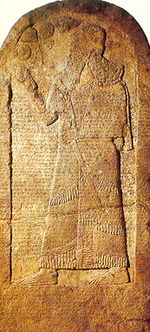Kurkh Monolith

The Monolith stelae of Shalmaneser III (above) and Ashurnasirpal II (below)
|
|
 |
|
| Material | Limestone |
|---|---|
| Size | 2.2m & 1.93m |
| Writing | Akkadian cuneiform |
| Created | c. 852 BC & 879 BC |
| Discovered | 1861 |
| Present location | British Museum |
| Identification | ME 118883 and ME 118884 |
Coordinates: 37°49′30″N 40°32′24″E / 37.825°N 40.54°E
The Kurkh Monoliths are two Assyrian stelae that contain a description of the reigns of Ashurnasirpal II and his son Shalmaneser III. The Monoliths were discovered in 1861 by a British archaeologist John George Taylor, who was the British Consul-General stationed in the Ottoman Eyalet of Kurdistan, in a town called Kurkh, which is now known as Üçtepe, in the district of Bismil, in the province of Diyarbakir of Turkey. Both stelae were donated by Taylor to the British Museum in 1863.
The Shalmaneser III monolith contains a description of the Battle of Qarqar at the end. This description contains the name "A-ha-ab-bu Sir-ila-a-a" which is generally accepted to be a reference to Ahab king of Israel, although it is the only reference to the term "Israel" in Assyrian and Babylonian records, which usually refer to the Northern Kingdom as the "House of Omri", a fact brought up by some scholars who dispute the proposed translation. It is also one of four known contemporary inscriptions containing the name of Israel, the others being the Merneptah Stele, the Tel Dan Stele, and the Mesha Stele. This description is also the oldest document that mentions the Arabs.
...
Wikipedia
